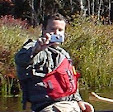Tent - a three-season tent will probably work fine for this trip, but a four-season tent is even better. A four-season tent is designed to withstand heavy snow and wind. The tent fabric is heavier, which allows it to retain heat better. I'll be using my father's Eureka! Expedition. You can't find this tent today, but it was originally designed as a mountaineering tent. Here are a couple of advertisements from the late 1980's.
When pitching a tent in snow, pack down the snow since loose snow is more likely to melt with body heat. Snowshoes work great, or just stamp it down with your boots. I put plastic ground cloths under the tent, and inside for extra protection. When staking a tent in frozen ground, use heavy-duty stakes or nails. In the snow, use snow stakes or a deadman stick.
Sleeping Bag – to ensure comfort on cold nights, it’s a good idea to use a bag that's rated at least 10° colder than the temperature you will be out in. I have my father's Sumberjack Quallofil winter bag with draft tubes at the zippers, and drawstrings at the shoulders and on the hood to help keep the heat in the bag. I can't tell from the bag itself, but it looks like what they used to sell as the Boundry 0.
Sleeping Pads - in cold weather its best to use two sleeping pads to keep from losing heat to the cold ground - a closed-cell foam pad on the tent floor, and an inflatable pad on top of that. Pads designed for winter use usually have an R-value of about 4.0 or higher. I'll use my father's ¼” closed-cell foam pad and a Klymit Static V insulated pad with an R-value of 4.4. I also have my father's original Therm-a-Rest - they don't make them like that anymore.
Clothes – as always, dress in layers to match the conditions – a base layer next to the skin, then insulating layers to provide warmth, and finally outer layers to protect against rain and wind. Look for synthetic fabrics or wool that dry quickly and wick perspiration away from your body. Don’t forget a hat, gloves and appropriate footwear for the conditions. Be sure to adjust your layering before you over-heat or get cold, and bring warm, dry cloths to sleep in.
Stoves - liquid-fuel stoves like the Whisperlite work fine in below-freezing temperatures. Canister stoves like my Jetboil need to be kept above freezing to produce vapors and work properly. When in doubt, cook on the fire.
Food – your body generates heat as it digests food, so if you’re feeling cold try eating some food. (Moving around will also help.) Before you go to bed, have a snack to keep your metabolism going and keep a candy bar nearby if you get cold in the middle of the night. I don't think we will need to worry about having enough food with this group.
Water - don't forget to stay hydrated. I usually bring jugged water, but in the winter you may need to pump or melt water.
I'm lucky that my father was a winter hiker, so I have a lot of his old gear. For real winter camping you need to get out in the snow, but we'll try that another time.
I'm lucky that my father was a winter hiker, so I have a lot of his old gear. For real winter camping you need to get out in the snow, but we'll try that another time.





No comments:
Post a Comment
Note: Only a member of this blog may post a comment.